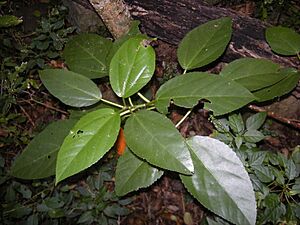Shining-leaved stinging tree facts for kids
Quick facts for kids Shining-leaved stinging tree |
|
|---|---|
 |
|
| Scientific classification |
The shining-leaved stinging tree (Dendrocnide photinophylla) is a cool rainforest tree found in eastern Australia. It grows from near the Colo River northwest of Sydney all the way up to Cooktown in tropical Queensland. This amazing tree can live in many different types of rainforests. Its scientific name, photinophylla, means "shining leaf," and "Dendrocnide" means "stinging tree."
Contents
What's in a Name?
This tree has lots of different nicknames! People call it fibrewood, small-leaved nettle, mulberry-leaved stinging tree, and even gympie.
The Sting: What You Need to Know
Stinging trees are famous for their tiny hairs that can cause a painful sting if they touch your skin. Because of this, hikers and nature lovers often try to avoid them. However, these trees are a really important part of the Australian rainforest ecosystem!
The sting from the shining-leaved stinging tree is not as strong as some of its relatives, like the gympie gympie tree. Still, it's a good idea to stay away from its leaves and branches to avoid any discomfort.
Meet the Shining-Leaved Stinging Tree
This tree can grow to be quite large, reaching up to 30 meters (about 100 feet) tall! Its trunk can be as wide as 75 centimeters (about 30 inches). The bark is usually smooth and grey, but it might have some small bumps or lines. Its smaller branches are smooth and grey, turning green at the tips.
Leaves and Flowers
The leaves of this tree are shiny and shaped like an oval. They are usually 6 to 13 centimeters long and 3 to 8 centimeters wide. You'll find those stinging hairs mostly on the veins of the leaves.
The tree produces yellowish-green flowers from November to June. Sometimes, male and female flowers grow on different trees. These flowers appear in small clusters from where the leaves meet the stem.
Fruit and Its Role in Nature
The fruit of the shining-leaved stinging tree are small, bumpy nuts. They look a bit like a bunch of white grubs and ripen between January and March. Even though the fruit has stinging hairs, many rainforest birds love to eat them. Birds like the regent bowerbird and the Torresian crow enjoy these fruits, helping to spread the tree's seeds.
How People Used This Tree
Long ago, Indigenous Australians used the strong fibers from this tree to make useful things like nets and bags.



